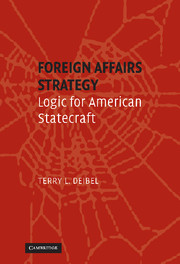Book contents
- Frontmatter
- Contents
- Preface and Acknowledgments
- 1 Introduction: Defining Strategy
- PART I ASSESS
- PART II ANALYZE
- PART III PLAN
- 6 The Instruments of State Power
- 7 Linking Ends and Means
- 8 Evaluating Courses of Action
- 9 Conclusion: American Foreign Affairs Strategy Today
- APPENDIX A Definitions of Grand Strategy, National Security Strategy, and Statecraft
- APPENDIX B A Linear Design for Foreign Affairs Strategy
- Index
7 - Linking Ends and Means
Published online by Cambridge University Press: 05 June 2014
- Frontmatter
- Contents
- Preface and Acknowledgments
- 1 Introduction: Defining Strategy
- PART I ASSESS
- PART II ANALYZE
- PART III PLAN
- 6 The Instruments of State Power
- 7 Linking Ends and Means
- 8 Evaluating Courses of Action
- 9 Conclusion: American Foreign Affairs Strategy Today
- APPENDIX A Definitions of Grand Strategy, National Security Strategy, and Statecraft
- APPENDIX B A Linear Design for Foreign Affairs Strategy
- Index
Summary
Defining the national interest, identifying threats and opportunities, validating assumptions about the strategic context, assessing domestic support, strengthening the nation's relative power and gauging its influence, buying instruments of statecraft and understanding their properties – all these are essential yet preliminary steps to the critical marriage of ends and means that lies at the heart of all strategy (see Figure 7.1). For after all these things are done, the strategist must still formulate specific objectives and decide exactly how to use instruments to achieve them.
Formulating such plans is the most difficult and important part of foreign affairs strategy, for it is the point at which limits must be recognized, costs and risks clarified, and priorities assigned. Trying to achieve one's chosen objectives, and doing so in particular ways, will have effects on other efforts to accomplish other objectives. These consequences must be weighed and the linkages between elements of strategy recognized and arranged, ideally in a manner that will cause the whole strategic construct to be more than the sum of its parts. Objective setting, in other words, is where everything comes together, where strategy either achieves coherence or fails to be strategy at all. Not surprisingly, it is where the enormity of the intellectual and practical challenge hits home.
In this chapter and the next, the focus will be on the “plan” level of the model for foreign affairs strategy (see Figure 7.2).
- Type
- Chapter
- Information
- Foreign Affairs StrategyLogic for American Statecraft, pp. 281 - 321Publisher: Cambridge University PressPrint publication year: 2007



